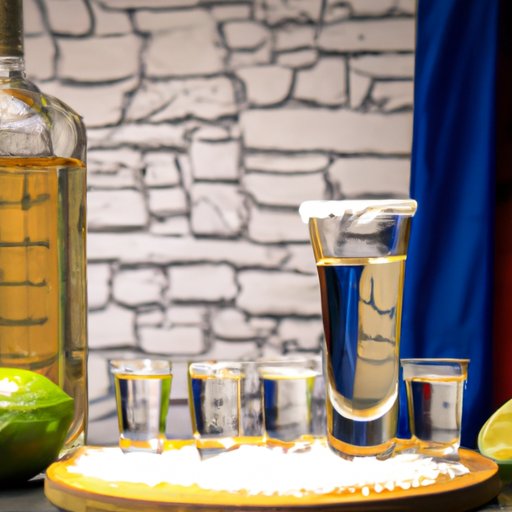Introduction
Tequila is an iconic spirit that has become a key part of the culture in Mexico and many countries around the world. But what exactly is tequila and where did it come from?
Tequila is a type of distilled alcoholic beverage made from the agave plant, which is native to Mexico. It is typically made from blue agave, but can also be made from other varieties of agave. It is usually clear or pale yellow in color, with a strong, distinctive flavor that is often mixed with other ingredients such as lime juice, sugar, and salt to create a variety of cocktails.
In this article, we explore the history of tequila, how it has evolved over time, the different types of tequila, the traditional process for making the spirit, and its potential health benefits. We will also discuss the countries with high tequila consumption and the various events related to the spirit.
Exploring the Origins of Tequila and Its Impact on Cuisine and Culture
The history of tequila dates back to the 16th century when the Spanish conquistadors arrived in Mexico. The indigenous people had been producing fermented drinks made from the agave plant for centuries before the arrival of the Spanish, and the conquistadors quickly adopted the practice. By the 17th century, tequila was being produced commercially in the region and soon became an important part of Mexican culture.
Tequila has evolved over time, with new production methods and recipes being developed. The spirit can now be classified into three main types: blanco (white), reposado (aged), and añejo (extra aged). Blanco tequila is the most common type and is usually unaged or aged for less than two months. Reposado tequila is aged for at least two months but no more than one year. Añejo tequila is aged for at least one year but no more than three years.
The traditional process for making tequila involves harvesting the agave plant, extracting the juice from the heart of the plant, fermenting the juice, and then distilling it. The resulting liquid is then bottled and labeled according to the type of tequila it is. It is also common for producers to add flavors and other ingredients to the tequila to create unique variations.
Tequila has become an integral part of Mexican cuisine and culture. It is commonly used in cooking and is served at celebrations, festivals, and other special occasions. It is also widely used in cocktails and other drinks. The spirit has become so popular that it is now exported to countries all over the world.
Health Benefits of Tequila
Tequila is often viewed as an unhealthy drink, but studies have shown that it may actually have some health benefits. Tequila is low in calories and carbohydrates, and contains small amounts of vitamins and minerals. In particular, it is a good source of manganese, magnesium, calcium, and potassium. It also contains antioxidants, which can help reduce inflammation and protect against disease.
Tequila has also been linked to improved digestion and gut health, as well as reduced risk of certain types of cancer. Additionally, moderate consumption of tequila has been found to improve cognitive function and memory. However, it is important to note that these potential benefits are only associated with moderate drinking, and excessive consumption can lead to serious health issues.

Popularity of Tequila Around the World
Tequila is extremely popular in Mexico, where it is consumed both straight and in cocktails. It is also widely consumed in the United States, where it is often enjoyed in margaritas and other popular drinks. Other countries with high tequila consumption include Spain, Germany, France, and the United Kingdom.
Tequila-related events are held regularly around the world. The most famous event is the Tequila Express, a train journey through Mexico’s tequila-producing region that includes tastings, lectures, and other activities related to the spirit. Other popular events include the Tequila & Mezcal Festival in Oaxaca, Mexico, and the San Francisco Margarita March.
Conclusion
Tequila has been a part of Mexican culture for centuries, and its popularity continues to grow around the world. While it is often associated with partying and excessive drinking, there are actually many potential health benefits associated with moderate consumption of the spirit. As the popularity of tequila continues to grow, so too do the number of events and activities related to the spirit.
The history of tequila is long and fascinating, and it is clear that the spirit is here to stay. Whether you enjoy it straight, in a cocktail, or simply appreciate its cultural significance, there is no denying that tequila is an important part of Mexican culture and a symbol of national pride.
(Note: Is this article not meeting your expectations? Do you have knowledge or insights to share? Unlock new opportunities and expand your reach by joining our authors team. Click Registration to join us and share your expertise with our readers.)
